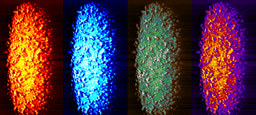Sugar fiend
Published in Chemistry, Microbiology, and Protocols & Methods

Akkermansia muciniphila (AM) is one of the many microbes inhabiting our colon, but it is unusual in the way it primarily uses the mucins in mucus as a carbon source. The secreted mucins in the colon are large glycoproteins released from goblet cells in the epithelial surface. As mucins are released, they unfold to form mesh structures and layers of these form the gel-like consistency of mucus. This mucus is the barrier between the host cells lining the colon and the large population of microbes in the colon. Other microbes in the colon can also access mucins, but most tend to have a more varied diet than AM.
AM is a member of the relatively understudied Planctomycetota-Verrucomicrobiota-Chlamydiota superphylum and has received considerable attention since its discovery two decades ago. This is partly due to multiple studies linking AM to markers of health rather than disease, so, for example, it has been observed to be higher in athletes and lower in people with inflammatory bowel disease. In terms of the mechanisms AM uses to interact with the host, research has also started to uncover how some of AM’s extracellular proteins interact with human receptors to likely dampen down the immune system. AM-like sequences have been observed in the digestive tracts of other animals, which emphasises our long evolutionary history with these mini-beasts.
Our work on AM originated with the characterisation of the enzymes that cut within an O-glycan mucin chain (glycoside hydrolase 16 family members). Following publication of this work, our side projects regularly included other enzymes encoded in the AM genome that we predicted would also act on mucin O-glycans and we usually gave these projects to undergraduate or master’s students. We had two particularly enthusiastic undergraduate students (Manon and Emily) who worked well together to characterise some of the AM enzymes targeting mucins and human milk oligosaccharides. This inspired us to finish off the AM work and Cassie, Tobi and I spent some time working together to achieve this. Cassie Bakshani is the star of this show, and she tirelessly and patiently pieced together which AM enzymes did what job. Cassie is a fantastic scientist and team member, so watch this space for more impactful science from her pipettes.
In this paper, we present the systematic and comprehensive screen of over 60 enzymes associated with the breakdown of mucin O-glycans. We demonstrate that a cocktail of these enzymes can breakdown the O-glycan chains of porcine gastric mucin completely, which is the first time this has been demonstrated. We also characterise the glycobiology occurring on the surface of AM, which has implications for its interactions with other members of the microbiota. Consequently, we have constructed a localisation model of different breakdown steps according to the current knowledge. Human milk oligosaccharides, gangliosides and globosides are also produced by the host and have features in common with O-glycans, so we were also able to demonstrate that AM has the potential to break these down too and which enzymes it can use to do this. Finally, we had the privilege of working with Bo Pilgaard and Jesper Holck from the Technical University of Denmark, who defined the kinetics and specificities of the enzymes active against glycoaminoglycans beautifully. Finally, thanks to my parents, Clare and Nick, who babysat late into the night when the experiments weren’t 9-5.
Despite the many informative studies on AM, there are still significant pieces of the puzzle missing. In this study we concentrate solely on the enzymes active against the glycans, but other groups have characterised some of the enzymes that target the peptide part of mucins. How these two types of enzymes work together is still yet to be completely defined. Other studies have reported that AM behaves differently in a community of species compared to alone and, although not a surprising observation, has highlighted a whole other dimension that studies like ours do not consider as a factor yet.
One of the impacts we hope to see from this work is the exploration of mucins in more detail. Mucins are highly variable between body sites, individuals and species. There are also links between some diseases (or predisposition to disease) and particular mucin structures or changes in mucin structure. Commensal and pathogenic microbes also interact with different mucin structures, so enzymes with defined activities against different mucins can probe the importance of these directly.
One of the most exciting aspects of AM to still be explored is its undescribed import system. A recent paper characterising a library of AM gene knockouts made significant progress in highlighting the putative proteins that comprise the import system, but the details of this are yet to be defined. This paper also observed large blobs of mucin within the AM cells, suggesting the mucin is harvested and then degraded inside the cell. Our own observations show that there is glycan breakdown occurring on the surface of the cell, so there is at least some pre-processing of the mucin prior to import. The exact details of this process are yet to be defined, but the characterisation of such an import system would be highly unique.
Follow the Topic
-
Nature Microbiology

An online-only monthly journal interested in all aspects of microorganisms, be it their evolution, physiology and cell biology; their interactions with each other, with a host or with an environment; or their societal significance.
Related Collections
With Collections, you can get published faster and increase your visibility.
Progress towards the Sustainable Development Goals
Publishing Model: Hybrid
Deadline: Ongoing
The Clinical Microbiome
Publishing Model: Hybrid
Deadline: Mar 11, 2026






Please sign in or register for FREE
If you are a registered user on Research Communities by Springer Nature, please sign in